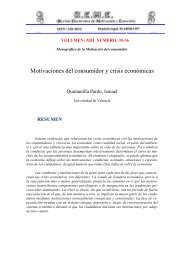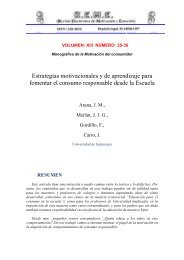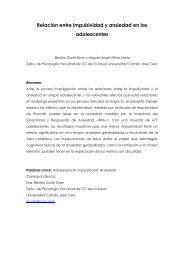Motivación y biología: desarrollos teóricos - Revista Electrónica de ...
Motivación y biología: desarrollos teóricos - Revista Electrónica de ...
Motivación y biología: desarrollos teóricos - Revista Electrónica de ...
Create successful ePaper yourself
Turn your PDF publications into a flip-book with our unique Google optimized e-Paper software.
<strong>Revista</strong> <strong>Electrónica</strong> <strong>de</strong> <strong>Motivación</strong> y Emoción http://reme.uji.es<br />
Schiefenhoevel, W. (1986). La agresión y el control <strong>de</strong> la agresión: Un ejemplo <strong>de</strong> Nueva<br />
Guinea y algunas consi<strong>de</strong>raciones generales sobre etología humana. En J. Sanmartín, V.<br />
Simón y M.L García-Merita (comps.): La Sociedad Naturalizada. Genética y Conducta<br />
(pp. 309-327). Valencia: Tirant lo Blanch.<br />
Schiefenhoevel, W. (1997). Universals in interpersonal interactions. En U.CH. Segerstrale y P.<br />
Molnar (eds.): Nonverbal communication: Where nature meets culture (pp. 61-85).<br />
Hillsdale, NJ: Lawrence Erlbaum Associates, Inc.<br />
Schlesinger, K. (1985). A brief introduction to a history of Psychology. En G.A. Kimble y K.<br />
Schlesinger (eds.): Topics in the History of Psychology. Vol. 1 (pp. 1-20). Hillsdale,<br />
Nueva Jersey: Lawrence Erlbaum Ass.<br />
Schultz, W. (1999). The primate basal ganglia and the voluntary control of behaviour.<br />
En B. Libet y A. Freeman (eds.): The Volitional Brain: Towards a Neuroscience<br />
of Free Will (pp. 31-45). Thorverton, Inglaterra: Imprint Aca<strong>de</strong>mic.<br />
Schulze, G. (1995). Motivation: Homeostatic mechanisms may instigate and shape adaptive<br />
behaviors through the generation of hedonic states. En R. Wong (ed): Biological<br />
Perspectives on Motivated Activities (pp. 265-288). Stamford, CT: Ablex Publishing<br />
Corp.<br />
Seligman, M.E.P. (1970). On the generality of the laws of learning. Psychological Review, 77,<br />
406-418.<br />
Seligman, M.E.P. y Hager, J.L. (1972). Biological Boundaris of Learning. Nueva York:<br />
Appleton-Century-Crofts.<br />
Sheldon, K.M.; Elliot, J.E.; Kim, Y. y Kasser, T. (2001). What is satisfying about satisfying<br />
events? Testing 10 candidate psychological needs. Journal of Personality and Social<br />
Psychology, 80(2), 325-339.<br />
Sherrington, Ch.S. (1906). The integrative action of nervous system. New Haven: Yale<br />
University Press.<br />
Simons, R.F.; Detenber, B.H.; Roe<strong>de</strong>ma, T.M. y Reiss, J.E. (1999). Emotion processing in three<br />
systems: The medium and the message. Psychophysiology, Vol 36(5), 619-627.<br />
Sluckin, W. (1973). Imprinting and Early Learning. Chicago: Aldine.<br />
Smith, D. (1996). Introduction. En R. Langs: The Evolution of the Emotion-Processing Mind.<br />
With an Introduction to Mental Darwinism (pp. xi-xvi). Londres: International<br />
Universities Press.<br />
Solbrig, O.T. (1966). Evolution and Systematics. Nueva York: Macmillan.<br />
Spencer, H. (1855). Principles of Psychology. Londres: Williams and Norgate.








